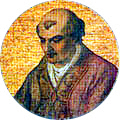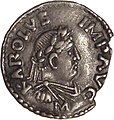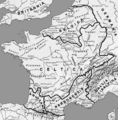Constitutio Romana
The Constitutio Romana (CR) was a contract signed on November 11, 824 between the Roman-Franconian Emperor Lothar I (795–855) and Pope Eugene II (824–827). The reason for this agreement was the fact that the papacy increasingly fell into the hands of rival noble families who came from Rome . Pope Eugene II. Also confirmed with the "Constitutio Lothari" the imperial powers and confirmed with her that a now Papstkonsekration could take place only after the Newly elected to the Emperor the pledge of allegiance had taken.
Lothar I, who had previously been surprisingly crowned emperor by Pope Paschal I (817–824), placed the election of the Pope under strict supervision with the CR . The weak position of the national kings but led to another problem, because now some noble families led as the real ruler of the Papal States , which at will and inserting popes deposed again. This ominous situation was to change for the first time in 1059 with the papal bull " In nomine Domini " ( papal election decree ) by Pope Nicholas II (1058-1061) and the Gregorian reforms under Gregory VII (1073-1085). Under Pope Gregory X. (1271–1276), in 1274, the rule was created to use a conclave to elect a pope .
history
As early as 781, Charlemagne installed his youngest son Ludwig (the pious) as viceroy in Aquitaine and, after the death of the two older sons, crowned him co-emperor without the blessing of the Pope. With the “ Ordinatio imperii ” of 815, Ludwig the Pious (778–840) appointed his son Lothar as co-king. In 816, Ludwig was crowned a second time in Reims by Pope Stephan IV (816–817) and in 817 issued an imperial inheritance order that secured his son Lothar, later Lothar I, as Roman-Franconian emperor, total rule over Aquitaine and Bavaria .
Shortly after the papal coronation of Lothar I, Pope Paschal I died in 824. Pope Eugene II followed the papal chair. Lothar I and his confidante Wala von Corbie designed the CR, with which the papal election was reorganized. This included that the electoral assembly should be composed of Roman clergymen and nobles, the elected had to take an oath on the emperor before the imperial representative ( Missus ), and the emperor appointed an envoy to the Holy See who also administered the papal state. In addition, Lothar I, after he had become King of Italy (843-855), stipulated that the election of the Pope could only be initiated by the imperial Missus. This meant that until the Gregorian reform, the right to propose remained with the German kingship.
Summary
The CR comprised a total of nine articles, in which far-reaching measures for the Papal States and the papal elections were specified, these included:
- All persons under the protection of the Pope or Emperor were considered inviolable, they were only obliged to obey the Emperor and Pope and were asked not to plunder the property of the Pope after his death.
- Two commissioners ( missi ) should be appointed, they should supervise the church administration and determine the procedures for the papal election.
- The CR made theft , robbery and violence against the Pope and his officials a serious criminal offense.
- The unconditional oath on the emperor and loyalty to the Pope was required.
- For the papal election, it was also stipulated that only the imperial envoys could convene and chair the papal assembly.
Tradition and edition
Alfred Boretius has the text of the CR on the basis of three manuscripts (from the Biblioteca Chigiana (Chis. F.IV.75), the library of the Abbey of Cava (Ms. Cavensis 22) and the Herzog August library in Wolfenbüttel (Blankenburg 130.52) ), which provide the full text, edited in 1883 in the first volume of the Capitularia regum Francorum . Excerpts from the Constitutio were used in canonical collections, including in the Liber Papiensis and in the canonical collection of Cardinal Deusdedit (especially in Vat. Lat. 3833).
literature
- Hubert Mordek : Constitutio Romana . In: Lexicon of the Middle Ages (LexMA). Volume 3, Artemis & Winkler, Munich / Zurich 1986, ISBN 3-7608-8903-4 , column 176 f. also refers to the Privilegium Ottonianum from 962 and the Heinricianum from 1020.
Web links
- Supplementary chapter to "Little Italian History" in the Reclam publishing house
- Digitized book: Church and State Through the Centuries, Sidney Z. Ehler (author); Chapter I .: The Roman Empire and the dark ages, "Constitutio Romana" of the Emperor Lothair I., November 824 , accessed June 11, 2013







